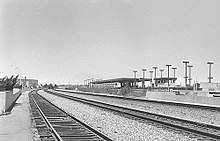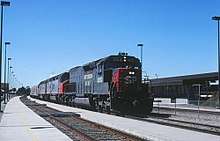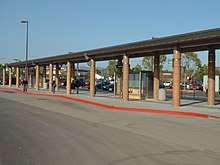Richmond station (California)
Richmond, CA | |||||||||||||||||||||||||||||||||||||
|---|---|---|---|---|---|---|---|---|---|---|---|---|---|---|---|---|---|---|---|---|---|---|---|---|---|---|---|---|---|---|---|---|---|---|---|---|---|
|
Richmond | |||||||||||||||||||||||||||||||||||||
%2C_April_2018.jpg) Richmond station entrance in April 2018 | |||||||||||||||||||||||||||||||||||||
| Location |
1700 Nevin Way Richmond, California | ||||||||||||||||||||||||||||||||||||
| Coordinates | 37°56′13″N 122°21′11″W / 37.936811°N 122.353095°WCoordinates: 37°56′13″N 122°21′11″W / 37.936811°N 122.353095°W | ||||||||||||||||||||||||||||||||||||
| Owned by | Union Pacific Railroad[1] | ||||||||||||||||||||||||||||||||||||
| Line(s) |
UP Martinez Subdivision[2] BART R-Line | ||||||||||||||||||||||||||||||||||||
| Platforms |
1 island platform (Amtrak) 1 island platform (BART) | ||||||||||||||||||||||||||||||||||||
| Tracks |
3 (Amtrak) 2 (BART) | ||||||||||||||||||||||||||||||||||||
| Connections |
| ||||||||||||||||||||||||||||||||||||
| Construction | |||||||||||||||||||||||||||||||||||||
| Parking | 624 spaces | ||||||||||||||||||||||||||||||||||||
| Bicycle facilities | Two lockers | ||||||||||||||||||||||||||||||||||||
| Disabled access | Yes | ||||||||||||||||||||||||||||||||||||
| Other information | |||||||||||||||||||||||||||||||||||||
| Station code | RIC (Amtrak) | ||||||||||||||||||||||||||||||||||||
| History | |||||||||||||||||||||||||||||||||||||
| Opened |
January 29, 1973 (BART)[3] c. 1978 (Amtrak)[lower-alpha 1] | ||||||||||||||||||||||||||||||||||||
| Rebuilt | October 18, 2007[1] | ||||||||||||||||||||||||||||||||||||
| Traffic | |||||||||||||||||||||||||||||||||||||
| Passengers (FY 2016) | 4,434 exits/day[4] (BART) | ||||||||||||||||||||||||||||||||||||
| Passengers (2017) |
292,453[5] | ||||||||||||||||||||||||||||||||||||
| Services | |||||||||||||||||||||||||||||||||||||
| |||||||||||||||||||||||||||||||||||||
The Richmond Transit Center is a Bay Area Rapid Transit (BART) and Amtrak station located in Richmond, California. Richmond is the north terminus of BART service on the Richmond–Warm Springs/South Fremont line and Richmond–Daly City/Millbrae line; it is a stop for Amtrak's Capitol Corridor, San Joaquin, and California Zephyr routes. It is one of two transfer points between BART and Amtrak, along with Oakland Coliseum station.
The Southern Pacific-controlled Northern Railway opened through what is now Richmond in 1878, but a station was not established until the arrival of the Atchison, Topeka and Santa Fe Railway in 1900. The station was closed upon the formation of Amtrak in 1971. Two years later, Richmond became the one of the termini of the initial BART system. Amtrak service began in 1978, with a shelter constructed in 1984. A new Amtrak platform was built in 2001, followed by a renovation of the whole station completed in 2007.
History
Southern Pacific and Santa Fe railroads
The Southern Pacific-controlled Northern Railway opened through the then-uninhabited swamplands near Point Richmond on January 8, 1878.[6] A stop was soon established at San Pablo, north of what is now Richmond.[7][8] Passenger service to Richmond started around 1900 when the Atchison, Topeka and Santa Fe Railway (ATSF) made Port Richmond the west terminus of its transcontinental mainline, where passengers could board ferries to San Francisco.[1] By 1910, the rapidly growing town of Richmond had four train stations: the Southern Pacific (SP) stopped in downtown Richmond near MacDonald Avenue and at Stege south of Potrero Avenue; the ATSF station was at the west end of MacDonald Avenue.[9]
Even as intercity rail service began to decline, Richmond was served by SP trains on the Shasta Route, Overland Route, and Central Valley routes, plus ATSF service to the Central Valley.[10] ATSF service ended in 1968 when the Golden Gate was discontinued. SP service to Richmond on the San Joaquin Daylight continued until May 1, 1971, when Amtrak took over intercity passenger service.[1]
BART

As early as 1957, Richmond was identified as a likely terminus for a line of a proposed regional rapid transit system.[11]:42 The system was approved by voters in November 1962.[3] The station was originally to be located at 6th and MacDonald west of downtown, but this was changed to 16th and Nevin (along the SP line) to allow construction of a storage yard north of the station and permit future extension. After tension between the Bay Area Rapid Transit District and the city, an agreement to use the latter site was reached in May 1967.[11]:106 BART service to Richmond began on January 29, 1973; it has remained a terminus since.[3] An extension to Crockett was considered in 1991 but not pursued.[3]
Intermodal station

Unlike other large cities, the Bay Area did not have a convenient transfer location between Amtrak intercity service and local rapid transit; Oakland Central Station was not located near a BART stop. The introduction of the San Joaquin service in 1974 added a third round trip to the SP mainline north of Oakland. The San Joaquin plus the long-distance San Francisco Zephyr and Coast Starlight began stopping at a small side platform near the BART station in late 1977 or early 1978.[lower-alpha 1] A station building with an elevator to the BART pedestrian access was built in 1984.[1] Service gradually expanded; a second San Joaquin was added in 1980, and the Capitols service began in 1991.[15] The Coast Starlight ceased to stop at Richmond in April 1996, followed by the California Zephyr (successor to the San Francisco Zephyr) in October 1998.[16]
The Amtrak station building was closed on December 1, 1997, though trains continued to stop.[17] On April 12, 2000, BART and the city broke ground on a "transit village", a large mixed-use transit-oriented development adjacent to the station.[3] In July 2001, the aging Amtrak facility was replaced with a modern island platform with better access to the BART pedestrian tunnel. The $1.9 million project, funded by the state, was intended to improve the station as preparation for the transit village.[16][18] The developer for the transit village - which included an 800-space garage for BART - was chosen in 2002.[3]
A $6.4 million renovation of the station was undergone as part of the transit village project. An "industrial post-modern" circular canopy was built over the station entrance. The station was officially named the Richmond Transit Center at a dedication ceremony on October 18, 2007.[1] A BART ticket window opened at the station in August 2008, joining seven other major stations in the system.[19] The two intercity trains began stopping at Richmond again on November 8, 2010. However, the Coast Starlight stop was again discontinued on January 14, 2013 because the train was scheduled to arrive at night - if it was several hours late, passengers would be unable to exit through the locked BART tunnel.[16] In 2018, BART and CCJPA installed a "courtesy light" on the Amtrak platform, which will instruct eastbound Capitol Corridor trains to hold for two minutes if a BART train is arriving to allow passengers to make their connection.[20]
Station layout
The BART station - a single island platform with two tracks - is located on the east side of the station complex. The Amtrak station - an island platform served by two of the three tracks of the Union Pacific Railroad Martinez Subdivision - is located to its west.[2] An under-track pedestrian tunnel connects the two platforms with entrances on both sides of the tracks. The east side has a BART parking lot; the transit village, bus bays, and parking garage are located near the large canopy on the west side.
Bus connections

Although Richmond is a terminal station for BART, most connecting regional bus services instead run to El Cerrito del Norte station, which is much closer to I-80. Richmond is served by several local bus services:
- AC Transit: local routes 70, 71, 72M, 76, 376; all-night route 800; school routes 607, 668, 675, 684
- Richmond Medical Center: BART-Kaiser Shuttle
- Richmond Circular Shuttle
A Golden Gate Transit route over the Richmond–San Rafael Bridge connecting Richmond to the agency's main service area in North Bay ran until 2015, when it was combined with a route that terminates at El Cerrito del Norte station.[21]
See also
References
- 1 2 3 4 5 6 7 "Richmond, CA (RIC)". Great American Stations. Amtrak. Retrieved November 24, 2017.
- 1 2 SMA Rail Consulting (April 2016). "California Passenger Rail NETWORK SCHEMATICS" (PDF). California Department of Transportation. p. 3.
- 1 2 3 4 5 6 "BART Chronology January 1947 – March 2009" (PDF). San Francisco Bay Area Rapid Transit District. March 2009. Archived from the original (PDF) on October 13, 2013.
- ↑ Bay Area Rapid Transit District. "Monthly Ridership Reports". Retrieved 6 February 2017.
- ↑ "Amtrak Fact Sheet, FY2017, State of California" (PDF). Amtrak. November 2017.
- ↑ Board of Railroad Commissioners of the State of California (1889). Annual Report of the Board of Railroad Commissioners of the State of California. p. 10 – via Google Books.
- ↑ "Map of California and Nevada". A.L. Bancroft & Co. 1882 – via David Rumsey Historical Map Collection.
- ↑ "(California and Nevada)". Rand McNally and Company. 1879 – via David Rumsey Historical Map Collection.
- ↑ New Richmond Land Company (1910). "Map of Richmond, California". Bolte & Braden Company – via David Rumsey Map Collection.
- ↑ The Friendly Southern Pacific Time Tables. Southern Pacific Railroad. January 15, 1954 – via Wikimedia Commons.
- 1 2 Healy, Michael C. (2016). BART: The Dramatic History of the Bay Area Rapid Transit System. Heyday. pp. 42, 106. ISBN 9781597143707.
- ↑ Sanders, Craig (2006). Amtrak in the Heartland. Bloomington, Indiana: Indiana University Press. pp. 155–156. ISBN 978-0-253-34705-3.
- ↑ Amtrak National Train Timetables. Amtrak. January 8, 1978. pp. 43–46 – via Museum of Railway Timetables.
- ↑ National Train Timetables. Amtrak. April 30, 1978. pp. 43–46 – via Museum of Railway Timetables.
- ↑ "'San Joaquin' trains catching on". Merced Sun-Star. July 30, 1982. Archived from the original on January 24, 2013.
- 1 2 3 Cox, Jeremiah (2016). "Richmond, CA". The Subway Nut.
- ↑ Vurek, Matthew Gerald (2016). California’s Capitol Corridor. Arcadia Publishing. p. 53. ISBN 9781467124171.
- ↑ Cabanatuan, Michael (July 20, 2001). "New station eases passengers from BART to Amtrak / Covered platform in Richmond is secure and comfortable". San Francisco Chronicle.
- ↑ "Ticket Exchange Window Opens at Richmond BART Station" (Press release). San Francisco Bay Area Rapid Transit District. August 4, 2008.
- ↑ "Capitol Corridor and BART unveil "courtesy light" at Richmond for easier transfer" (Press release). San Francisco Bay Area Rapid Transit District. January 31, 2018.
- ↑ "GGT Routes 40 & 42 Merging - Service to Richmond BART Station Discontinued" (Press release). Golden Gate Bridge, Highway and Transportation District. November 10, 2015.
Notes
- 1 2 Amtrak's Great American Stations website gives "early 1978" as the start of San Joaquins service at Richmond.[1] Sanders claims the San Francisco Zephyr began stopping on October 30, 1977, but stopped serving it on April 30, 1978.[12] The station is listed as a stop for all three trains in the January 8, 1978 and April 30, 1978 Amtrak timetables.[13][14]
External links
| Wikimedia Commons has media related to Richmond station (California). |
- BART - Richmond
- Capitol Corridor - Richmond
- Amtrak - Richmond
- Richmond (RIC)--Great American Stations (Amtrak)